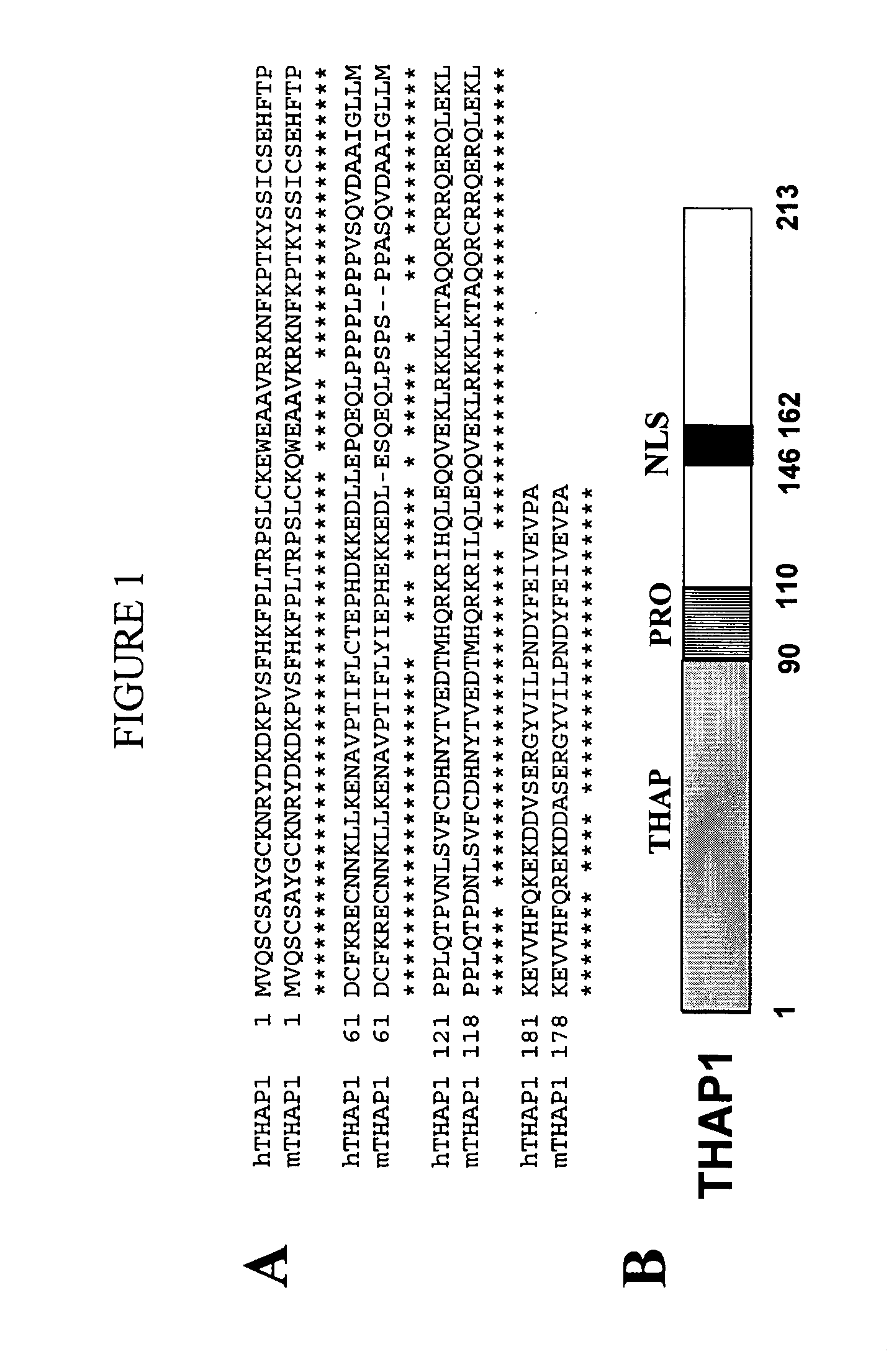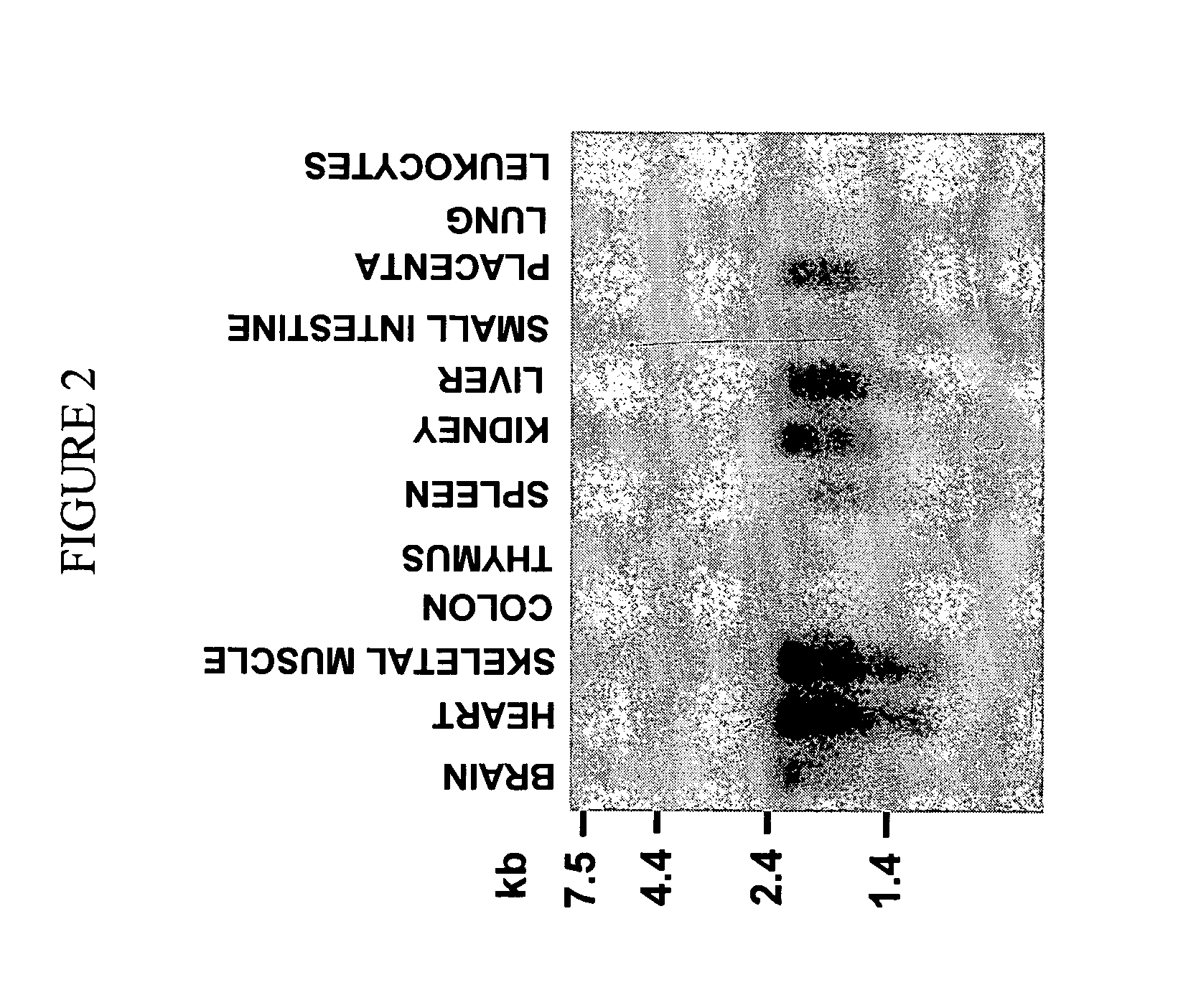Chemokine-binding protein and methods of use
a chemokine-binding protein and protein technology, applied in the field of chemokine-binding proteins, can solve the problems of poorly understood mechanisms by severely impaired primary t cell responses, and inability to fully understand the mechanism through which pml modulates the response to pro-apoptotic stimuli
- Summary
- Abstract
- Description
- Claims
- Application Information
AI Technical Summary
Benefits of technology
Problems solved by technology
Method used
Image
Examples
example 1
Isolation of the THAP1 cDNA in a two-hybrid screen with chemokine SLC / CCL21
[0943] In an effort to define the function of novel HEVEC proteins and the cellular pathways involved, we used different baits to screen a two-hybrid cDNA library generated from microvascular human HEV endothelial cells (HEVEC). HEVEC were purified from human tonsils by immunomagnetic selection with monoclonal antibody MECA-79 as previously described (Girard and Springer (1995) Immunity 2:113-123). The SMART PCR cDNA library Construction Kit (Clontech, Palo Alto, Calif., USA) was first used to generate full-length cDNAs from 1 μg HEVEC total RNA. Oligo-dT-primed HEVEC cDNA were then digested with SfiI and directionally cloned into pGAD424-Sfi, a two-hybrid vector generated by inserting a SfiI linker (5′-GAATTCGGCCATTATGGCCTGCAGGATCCGGCCGCCTCGGCCCAGGATCC-3′) (SEQ ID NO: 181) between EcoRI and BamHI cloning sites of pGAD424 (Clontech). The resulting pGAD424-HEVEC cDNA two-hybrid library (mean insert size >1 kb...
example 2
[0944] To determine the tissue distribution of THAP1 mRNA, we performed Northern blot analysis of 12 different adult human tissues (FIG. 2). Multiple Human Tissues Northern Blots (CLONTECH) were hydridized according to manufacturer's instructions. The probe was a PCR product corresponding to the THAP1 ORF, 32P-labeled with the Prime-a-Gene Labeling System (PROMEGA).A 2.2-kb mRNA band was detected in brain, heart, skeletal muscle, kidney, liver, and placenta. In addition to the major 2.2 kb band, lower molecular weight bands were detected, that are likely to correspond to alternative splicing or polyadenylation of the THAP1 pre-mRNA. The presence of THAP1 mRNAs in many different tissues suggests that THAP1 has a widespread, although not ubiquitous, tissue distribution in the human body.
example 3
Analysis of the Subcellular THAP1 Localization
[0945] To analyze the subcellular localization of the THAP1 protein, the THAP1 cDNA was fused to the coding sequence of GFP (Green Fluorescent Protein). The full-length coding region of THAP1 was amplified by PCR from HEVEC cDNA with primers 2HMR10 (5′-CCGAATTCAGGATGGTGCAGTCCTGCTCCGCCT-3′) (SEQ ID NO: 185) and 2HMR9 (5′-CGCGGATCCTGCTGGTACTTCAACTATTTCAAAGTAGTC-3′) (SEQ ID NO: 186), digested with EcoRI and BamHI, and cloned in frame downstream of the Enhanced Green Fluorescent Protein (EGFP) ORF in pEGFP.C2 vector (Clontech) to generate pEGFP.C2-THAP1. The GFP / THAP1 expression construct was then transfected into human primary endothelial cells from umbilical vein (HUVEC, PromoCell, Heidelberg, Germany). HUVEC were grown in complete ECGM medium (PromoCell, Heidelberg, Germany), plated on coverslips and transiently transfected in RPMI medium using GeneJammer transfection reagent according to manufacturer instructions (Stratagene, La Jolla, ...
PUM
| Property | Measurement | Unit |
|---|---|---|
| affinity | aaaaa | aaaaa |
| binding affinity | aaaaa | aaaaa |
Abstract
Description
Claims
Application Information
 Login to View More
Login to View More - R&D
- Intellectual Property
- Life Sciences
- Materials
- Tech Scout
- Unparalleled Data Quality
- Higher Quality Content
- 60% Fewer Hallucinations
Browse by: Latest US Patents, China's latest patents, Technical Efficacy Thesaurus, Application Domain, Technology Topic, Popular Technical Reports.
© 2025 PatSnap. All rights reserved.Legal|Privacy policy|Modern Slavery Act Transparency Statement|Sitemap|About US| Contact US: help@patsnap.com



